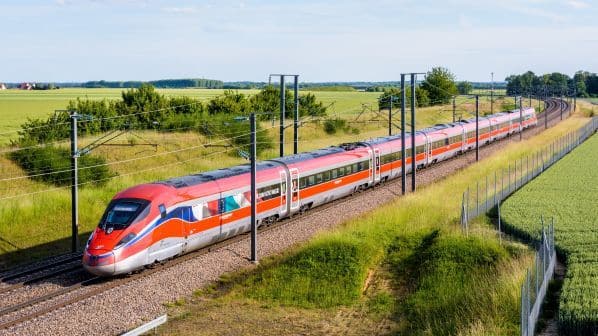A report on smart and affordable rail services in the European Union (EU) calls for the development of a masterplan to increase the size of the EU’s high-speed network to 49,400km by 2050, connecting all capitals and major cities to obtain a modal share that could grow to 54% by 2070.
The report is based on a study undertaken by Ernst & Young in collaboration with Bocconi University of Milan and Blue Arches. They were commissioned by the Europe’s Rail joint research undertaking, the Community of European Railway and Infrastructure Companies (CER), the Alliance of Passenger Rail New Entrants in Europe (AllRail) and the European Railway Industry Association (Unife).
“We strongly support the outcome of this study,” says Europe’s Rail executive director, Mr Carlo Borghini. “At the moment we do not have a high-speed network in Europe. We have a series of islands.”
According to the study, investing in a comprehensive network connecting all cities with over 250,000 inhabitants would deliver added value to society and massively reduce the environmental impact of passenger transport in Europe, creating “sustainable and equitable mobility.”
Building on the findings of recent academic studies, the partners investigated three network scenarios, starting as its baseline with the current network comprising 15,200km of high-speed lines.
The study says that without new investment, demand for high-speed rail travel and its modal share are expected to increase slowly, with the result that the targets of the EU’s Smart and Sustainable Mobility Strategy to double traffic by 2030 and treble it by 2050 will not be achieved.
High-speed rail’s modal share would rise from around 7% in 2021 to 9% in 2030 and only 13% in 2050, competing in the passenger transport market with conventional rail, long-distance travel by coach and private car and short-haul aviation.
The 2030 scenario is based on completing the 5,300km of high-speed lines included in the Core Network of the EU’s Trans-European Transport Network (TEN-T) programme. The resulting 20,500km would lead to a limited increase of about 16 percentage points in the modal share of high-speed rail, more than doubling the baseline 2021 figure.
To calculate the net present value (NPV) and benefit:cost ratio (BCR) of the 2030 scenario, the study used three values to estimate construction costs. Taking the lowest figure of €12m per km gives a total construction cost of €63bn, resulting in an NPV of €447.5bn and a BCR of 10.
The 2030 scenario would also reduce emissions by 1.5 billion tomes of CO2.
The “ambitious” investment programme that forms the basis for the 2050 scenario would see all major urban agglomerations in the EU connected by a comprehensive high-speed network, in addition to the TEN-T Extended Core network due for completion by 2040 and the Comprehensive Network to be completed by 2050.
Taking the total route length to 49,400km, the 2050 scenario also envisages significant expansion in eastern Europe compared to the baseline, adding Hungary, Romania and Bulgaria, as well as Moldova and Ukraine, to the European high-speed map.
Building these new routes at €12m per km would cost €410bn, giving an NPV of €836.7bn and a BCR of 4.
It would also almost triple the amount of CO2 saved compared with the 2030 scenario and potentially make high-speed rail the dominant mode with a market share of 54% by 2070, while generating “considerable socio-economic benefits for European society” worth up to €750bn over the same period.
Study sponsors Europe’s Rail, CER, AllRail and Unife are now proposing that a masterplan is drawn up to connect all EU capitals and major cities by high-speed rail, calling on the European Commission and member states to implement a coordinated implementation programme “with adequate funding now and for the decades to come.”
“The positive cost:benefit ratio of the study shows why Europe needs a high-speed masterplan as a response to the ongoing energy and sustainable mobility crisis,” says CER executive director, Mr Alberto Mazzola.
“Railway investment requires long-term commitment and sufficient funding. The TEN-T Regulation, currently under revision, must recognise this.”
“By demonstrating the major economic and environmental benefits of a European high-speed rail network, the study will underpin the Sustainable and Smart Mobility Strategy and its ambitious objective to double traffic on high-speed rail by 2030 and to triple it by 2050,” says Unife director general, Mr Philippe Citroën.
“Independent passenger rail companies enthusiastically support the fast growth of high-speed rail in Europe,” says AllRail secretary general, Mr Nick Brooks.
“We want to see it displace the private individual motor car as a product for the masses, for everyone from the budget conscious to very affluent travellers. High-speed rail must form the backbone of speedy door-to-door travel across the EU.”

